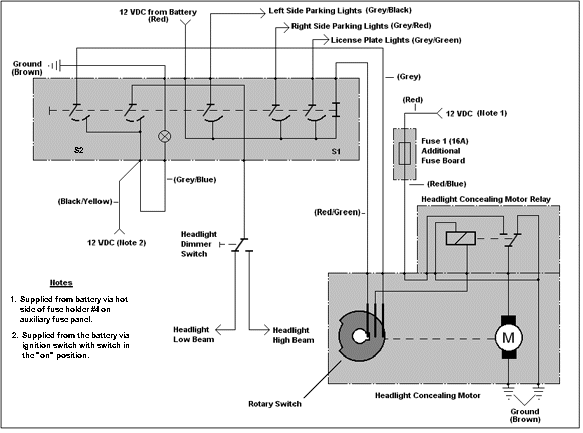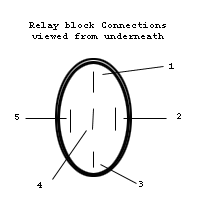sounds like your weekend is sorted then ![8|]
nothing for it but to check everything.not sure if your model has the headlight relays housed in rubber protectors next to the headlight pods like the S2 does but you might start there. it sounds like your light switch may be faulty
WARNING : be very careful around the headlamp pods. Their motors are extremly powerful and will seriously mangle your hands if they operate without warning with your hands near them
http://www.clarks-garage.com/
look in the Garage shop manual section under headlights
Introduction The following procedure, written by Dave Simms, is based on the headlight motor circuits in 1983 and 1984 model 944s. Dave has also included information on how the motor circuits in later 944s differ from those of the early cars. However, the theory of operation and repair methods remain the same. I've added a few notes along the way and a different circuit diagram (with Dave's approval). We plan to expand this procedure down the road to describe how the entire exterior lighting circuit works in detail. But first, I have to figure out exactly how the bridge adapter in the later model 944 works. I'd like to thank Dave for his valuable contribution to
Clark's Garage.
![. [FONT=verdana,geneva"] [FONT=verdana,geneva"]](/forum/styles/default/pcgb/space.gif) Clark Fletcher
Clark Fletcher![. [FONT=verdana,geneva"] [FONT=verdana,geneva"]](/forum/styles/default/pcgb/space.gif) Foreword by the Author
Foreword by the Author My 944 had been reclaimed from an insurance company following a vandalism claim. The car had gone to a yard where some parts had been sold from it. In the process, the wiring harness had been cut in the front of the car and the headlight motor had been sold. When I purchased the car, the headlight motor in it had come from another wreck and was not connected. The internal circuit under the relay block had been rewired incorrectly. Finally, the mechanical headlight linkage was binding and several of the cap screws were loose. Surprisingly, most of the car was fine. So far, I have rebuilt all of the brake calipers, resurfaced or replaced all of the rotors, repacked the CV joints, fixed a number of electrical problems and cured some ills in the cooling system. I have learned that one of the most important things about the 944 is the assortment of clips and clamps that hold the various tubes, wires and hoses in place. When I got the car, the top rad hose was not clamped in place. One result was the circular-saw effect that had been applied by the alternator pulley to the hose. Cars that have seen work done by a number of different people may be subject to sloppiness in the area of what appears to be unimportant details. I'm resigned to the fact that, if I want a reliable car, the details
must be identical to the way they were when the car left the factory. All told, I am enjoying working through the various systems of the 944, checking and rebuilding them. The car is different and my work has been an education. I have strived to do every task,
by the book. Restoring the car's performance and reliability is my aim.
![. [FONT=verdana,geneva"] [FONT=verdana,geneva"]](/forum/styles/default/pcgb/space.gif) David Simms, Kamloops, BC, Canada
David Simms, Kamloops, BC, Canada ![. [FONT=verdana,geneva"] [FONT=verdana,geneva"]](/forum/styles/default/pcgb/space.gif) 1983-84 Porsche 944
1983-84 Porsche 944
Headlight Motor Circuit, Operation and Repair Components
- Motor
- Worm gear / Rotary Switch : This switch has three brushes which ride on a conducting disk. The inner brush has a cut-out that interrupts the current when the headlights have reached the off position. The center brush has an uninterrupted path. The outside brush has a cut-out that interrupts the current when the headlights have reached the on position.
- Relay This normally-off relay controls the motor. Uses Red/Blue conductor.
- Four Conductors: Control wires :Grey, Red/Green. Supply wire :Red/Blue. Ground Wire : Brown.
- S1 Normally-on switch, controlled by the headlight dash switch. Uses Red/Green conductor.
- S2 Normally-off switch, same as above. Uses Grey conductor.
- Dash Light Switch controls S1 and S2.
Theory of Operation
- Initially, the ignition switch is on and the headlights are off. S1 is closed and the red/green conductor has 12 volts on it. The inner brush of the rotary switch resides on its cut-out. No current flows to the relay coil.
- The dash headlight switch is turned to on. Switch S1 is turned off (no effect). S2 is turned on, the grey conductor goes from zero to 12 volts. The outside brush on the rotary switch allows current to energize the relay coil. The relay closes the contact allowing current to flow along Red/Blue to the motor. The motor operates until the outside brush in the rotary switch meets its cut-out. Current to the relay is now interrupted. The motor turns off. The headlights are now in their on position. NOTE The first position on the headlight switch turns on the parking and license plate lights. The second position on the switch turns on the headlights and energizes the concealing motor to raise the headlights. C.F.
- The grey conductor still has 12 volts and the Red/green one has 0 volts.
- The dash headlight switch is now turned to the off position.
- S2 opens and S1 closes.
- The grey conductor goes to 0 volts, the Red/green one to 12 volts.
- The inner brush on the rotary switch energizes the relay coil. The motor operates until the inner brush touches its cut-out, turning off the relay and the motor. The headlights are now in their off position.
- This completes one cycle of headlight motor operation.
NOTE If you've ever tried to operate raise the headlights manually, you probably found that when you reached a certain point raising the headlights that they automatically went back down. That's because the headlight concealing motor energizes to both raise and lower the headlights. As you rotate the dial on the motor, you also move the rotary switch. With the
S1 switch closed, when the rotary switch contact is made, the motor energizes and returns to the closed position. If you wish to raise the headlights manually, you must remove Fuse #1 on the auxiliary fuse panel for early 944s or Fuse #2 on the main fuse panel for later model 944s.
C.F. Notes Regarding the 1985 1/2 and more Recent Models Similarities & Differences Between Early/Late Models:
- Basic principles of Operation are the Same
- The Grey control wire is now Yellow/Blue
- The control wires are now fused
- The Red/Green wire requires a 7.5 A fuse in holder no.16
- The Yellow/Blue wire takes a 7.5 A fuse in holder no.37
- The Red/Blue supply wire takes a 25 A fuse in holder no. 2
- These fuses must be checked before undertaking any repairs
Maintenance Suggestions
- If the car is new-to-you, check the fuse values: 16 amps in the no. 1 fuse holder on the Additional Fuse Box (Early 944s). For later cars, check the three fuses listed above.
- Turn the manual control knob on the headlight motor to take the system through one cycle, note any points of excessive resistance. Remember to remove the motor fuses before trying to cycle the motor manually. Try to locate where the rubbing occurs. It will probably occur where the headlight assembly passes through the bodywork. You may need to remove foreign material. Or, you may need to adjust the alignment of the linkage. Note the sheet metal tabs on either side of the car above the radiator. On each tab are three small cap screws. You can make small adjustments to the linkage here.
- Your car may have sustained front-end damage and folds in the body metal may be rubbing on the headlight housings as they change position. Consult a body man if this is preventing the proper operation of the headlight linkage.
- Grease the ball-joints in the linkage with lithium-based grease. Proper lubrication will make a surprising difference in the resistance encountered by the headlight concealing motor.
Repair Procedures
- Headlights too low or too high
Start the car. Turn on the headlights. Unscrew the linkage from the motor shaft without turning it. Reposition the headlights manually while holding the linkage that you just removed from the motor. Reconnect the linkage to the motor shaft. Try turning the headlights on / off once more to verify the correct position. Repeat the procedure, if necessary.
- Headlights turn on but do not move
Check Fuses. On the '85 1/2 and later models, the control wires are fused too. The headlight motor assembly will probably have to be removed from the car. First, disconnect the 4-pin connector to the motor.
Check the voltages on the conductors.
- Motor or ignition on Light switch off. Brown and grey: 0 volts, Red/Green and Red/Blue: 12 volts
- Motor or ignition on Light switch on. Brown and Red/Green: 0 volts. Grey and Red/Blue: 12 volts.
- Motor or ignition off Light switchoff . Brown and grey : 0 volts. Red/Green and Red/Blue : 12 volts.
- If the voltages are not as above, the problem lies in the headlight relay or dash switch. Remove and check them with an ohmmeter. Check the continuity of the conductors. Have fun !!
- If the voltages have the prescribed values, remove the motor assembly. The unit will have to be bench-tested.
Bench-testing the motor unit
- Remove unit from car.
- Disconnect motor shaft from linkage.
- Remove four-pin electrical connector from motor assembly
- Remove the three screws holding the unit to the car
- Remove the rubber covers from the motor assembly
- Do a visual/electrical check of components
- Check condition of the relay points. If they are burned, file the points or replace the relay.
- Check continuity of relay coil with an ohmmeter. The wire is fine and can easily break. The resistance of the coil is about 65 Ohms. If there is no continuity, the relay will need to be replaced.
- If the above checks out all right, remove the relay block from the motor.
- Check the male and female connectors in the four-pin connector for damage. You may need to bring the unit to your local supplier to get compatible connectors if they are damaged.
- Check wiring of the relay block.
terminals 1 & 3: To motor and Red/Blue.
terminals 2 & 5: To the relay coil, from ground and center brush on rotary switch
terminal 5: No connection.
- Remove the rotary switch cover and check the brushes.
If a brush is damaged, it can be removed by de-soldering it from the external wire. You may be able to get a replacement from an appliance repairman or to fashion one from a piece of flat brass. The amount of current flowing through these brushes is negligible if everything is working properly. Therefore, the construction of these brushes, apart from their length, is not critical.
This is probably the least likely area of failure. Remove the motor relay from the relay block by prying gently with a screwdriver. Fit a spade-type female connector to a piece of wire and insert it into the relay side of terminal 1 or 3 (whichever will connect to the green motor wire). Connect the case of the motor to the negative terminal of a battery or battery charger and the other wire to the positive terminal. If the motor does not turn, look for a poor connection, otherwise, a new motor is required.
- Repairing the rubber boots. With time and temperature changes, the rubber boots protecting your headlight motor may have split along their seams.
- Clean and lightly sand the areas adjoining the split.
- Apply tape to the inside of the split so that the boot is held together.
- Apply several layers of automotive GOOP to the split, allowing each layer to dry before applying the next.
- Remove the tape and apply layers of GOOP to the inside of the split.
- Trim off any excess. Your boot should be able to withstand some vigorous stretching as it is put back on the motor.
Clark's Garage © 1998


![. [FONT=verdana,geneva"] [FONT=verdana,geneva"]](/forum/styles/default/pcgb/space.gif) Clark Fletcher
Clark Fletcher








